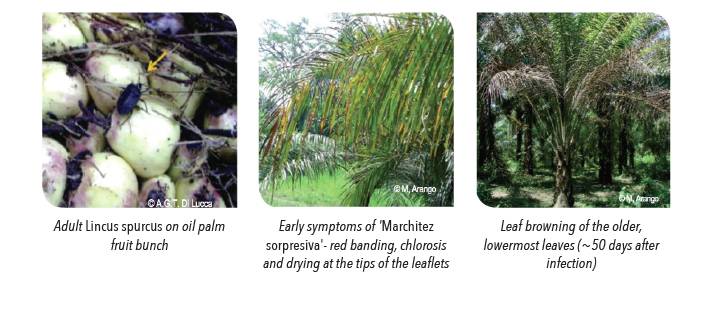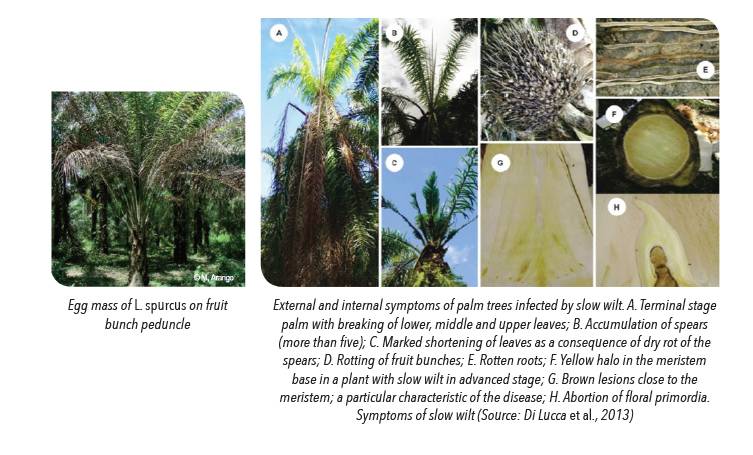General Information

Lincus spurcus is a vector of the disease ‘Marchitez sorpresiva‘ of Elaeis guineensis Jacq. and hartrort of Cocos nucifera in Peru. Both diseases are caused by the same pathogen, the protozoan Phytomonas staheli.
Marchitez sorpresiva or sudden wilt is one of the commonest oil palm disease in Latin America. The disease is characterised by the rotting of the palm heart. Other symptoms of the disease include i) browning of the older, lower leaves that progresses upwards to the younger leaves; ii) necrosis of freshly opened inflorescences, iii) premature nutfall of young fruits. Crown foliage may also be affected by secondary bacterial/fungal infection. Palms often die within 2-3 months after the onset of symptoms, but this may vary depending on palm variety.
L. spurcus also transmits the other form of marchitez on oil palm in Peru, the slow wilt. External symptoms of the slow wilt: i) chlorosis, drying and breaking of the lower leaves, ii) rot in fruit bunches, and iii) accumulation and rot of spears. Internally, the meristem display similar symptoms as the sudden wilt: brown lesions with a yellowish halo around its base. A high proportion (94%) of affected plants also had trypanosomatid protozoans in their roots. Affected palms die between 5 and 8 months after onset of symptoms.
The protozoans for both sudden and slow wilt inhabit the sieve tubes of palms. Adults of L. spurcus carry and transmit the protozoan during feeding. L. spurcus feed on the axils of the leaf petioles. Sucking the sap of the epidermis of young leaves near the trunk. They are attracted by the aromatic volatile compounds of the inflorescences, which guide them to new palms. Adults are photophobic and disperse by night flight.
Distribution
Peru
Detection and Inspection
ADULT
Dark coloured.
NYMPHS
Potentially similar in size to L. lethifer – 2 mm in length.
EGGS
Laid in groups of 7-8 in straight rows of about 7 mm in length on leaf sheaths and peduncles. Each egg is pearly grey and ornamented at its upper side. Analysis of volatile compounds produced in the metathoracic scent glands can also be used to confirm presence of L. spurcus.
Extracts of the scent glands is analysed using capillary gas chromatography (GC) and GC-mass spectrometry (GC-MS). The presence of (E)-2-hexenal, (E)-2-hexenoic acid, decane, (E)-2-octenal, undecene, undecane, (E)-2-octenly acetate, (E)-2-decenal, tridecane, (E)-2-decenyl acetate, (E)-2-hexenal, (E)-2-octenal and n-undecane is diagnostic of L. spurcus.

Prevention and Control
PHYTOSANITARY
The import of germplasm material (seeds, pollen, tissue culture) must be accompanied by an import permit issued by or on behalf of the Director-General of Agriculture for Peninsular Malaysia (including Labuan), or the Director of Agriculture for Sabah, and a phytosanitary certificate issued by an authorised official from the country of export. The import conditions are available upon request from the Plant Biosecurity Division Malaysia. All consignments are subjected to inspection by the Agricultural Department prior to clearance by Customs. Germplasm material imported from high risk areas should be sent for third country quarantine before arrival onto Malaysian shores. The import of alternative host plants/planting materials e.g. Scheelea sp., Bactris gasipaes, Astrocaryum carnosum from infested areas should be enquired with DOA.
CULTURAL CONTROL AND SANITARY METHODS
Cultural control and maintaining field hygiene is crucial in controlling insect population. The pentatomid seek refuge in moist plant debris and in weeds during daytime. Treatment with acephate through trunk injection can be applied in order to control the beetle.
Further reading
- Arango, M; Pineda, B; Martinez, G and Villegas, B (2011). Consideraciones epidemiológicas y etiológicas de la marchitez sorpresiva en palma de aceite en la Zona Norte de Colombia. Palmas, 32(1): 35-44.
- Di Lucca, A G T; Chipana, E F T; Albujar, M J T; Peralta, W D; Piedra, Y C M and Zelada, J L A (2013). Slow wilt: another form of Marchitez in oil palm associated with trypanosomatids in Peru. Trop. Plant Patho. 38(6): 522- 533.
- Howard, F W; Moore, D; Giblin-Davis, R M and Abad, R G (2001). Insects on Palms. CABI: UK. 400 pp.
- Llosa, J F; Couturier, G and Kahn, F (1990). Notes on the Ecology of Lincus spurcus and L. malevolus (Heteroptera: Pentatomidae: Discocephaline) on Palmae in Forests of Peruvian Amazonia. Ann.. Soc. Ent. Fr. (N.S.) 26(2): 249- 254.
- Mariau, D (2001). The fauna of oil palm and coconut: Insect and mites pests and their natural enemies. La Librairie du CIRAD: France. 264 pp.
- Panizzi, A R; Mcpherson, J E; James, D G; Javahery, M and Mcpherson, R M (2000). Stink bugs (Pentatomidae). In Heteroptera of Economic Importance. CRC Press: USA. p. 421-474.

